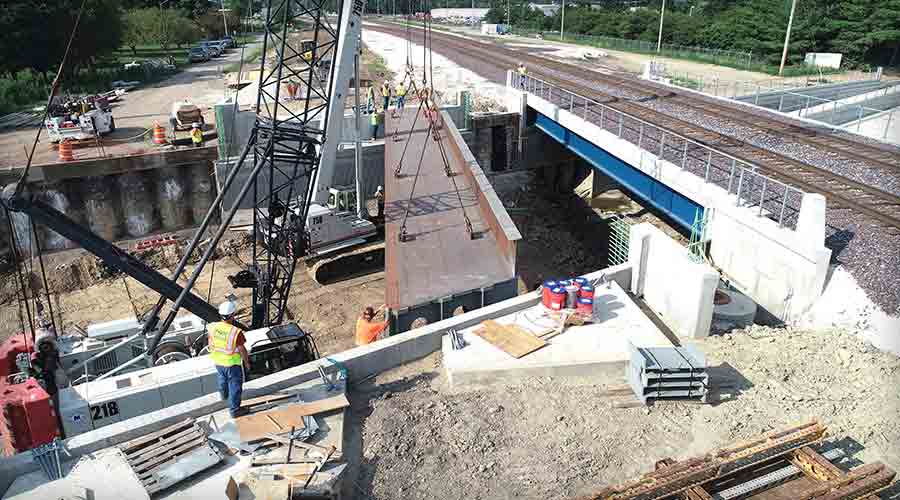Massive Springfield rail project marches on toward 2025 completion
11/7/2022
By Jeff Stagl, Managing Editor
A major rail project that’s a little more than halfway complete in Springfield, Illinois, is considered by many stakeholders to be a very big deal.
How big? The $475 million project is anticipated to have the biggest impact on the city since the state capital was moved from Vandalia to Springfield in 1839.
The Springfield Rail Improvements Project promises to change the transportation landscape in the area for generations to come, serve as an economic and downtown redevelopment catalyst, enable the city’s large medical district to expand, promote multimodal connectivity, improve older neighborhoods’ livability and boost transportation safety.
Divided into six work segments, the project calls for creating a six-mile rail corridor with two sets of tracks along the existing 10th Street rail corridor in the heart of the city. The goal: to consolidate all freight- and passenger-rail traffic — involving Amtrak, CN, Norfolk Southern Railway and Union Pacific Railroad — onto one rail corridor instead of the two that exist now. The Amtrak/UP and NS corridors run through downtown Springfield.
The project includes the construction of eight underpasses, one overpass and 20 new grade separations in total, as well as the replacement of four rail bridges and 36 grade crossing closures. The number of crossings in the project area will be reduced from 68 to 32. To prevent trespassing, the entire new corridor will be fenced.
The project partners include the four railroads, city, Sangamon County, Illinois Department of Transportation (IDOT), Federal Railroad Administration and Hanson Professional Services Inc., which designs and manages the work components.
The Springfield Rail Improvements Project also factors into two new major transportation facilities coming to the corridor: an Amtrak station and parking garage that’s slated to start in mid-2023 and be completed in 2025, and a Sangamon Mass Transit District transportation center that’s under construction and scheduled to open in mid-2023.
Now about 60% complete since it began in 2019, the rail project is expected to wrap up by 2025’s end.
The Springfield Rail Improvements Project is one of the longest and nearly continuous-running construction undertakings the NS Public Projects Department has ever handled, says Andrew Vollmer, a regional manager in the Class I’s real estate department. By the time it’s completed, the project will have covered a nearly 15-year construction cycle.
The multiple partners have maintained strong ties throughout the project, from the visionary stages through implementation, says Vollmer. The federal, state and local government partners helped secure federal and state funding for the entire project, including six federal grants.
In addition, the public partners were willing to segment the project into digestible construction pieces rather than pursue an “all-or-nothing” approach and have collaborated well with NS from the onset, says Vollmer.
“Accordingly, we have been willing and able to internally prioritize resources for the 10th Street corridor consolidation in the face of extensive engineering design plans, aggressive construction bid letting schedules and complex construction phasing coordination,” he says.
For Springfield residents and visitors, the project will help make road travel safer, especially in the downtown area.
“The advantage to the public is that all trains will only go through one area and there won’t be as many crossings,” says Vollmer.
For NS, the railroad will gain more efficiencies with a new mainline and a new 9,000-foot signalized siding.
 The ongoing project includes eight underpasses, one overpass, 20 grade separations and the replacement of four rail bridges. Norfolk Southern Railway
The ongoing project includes eight underpasses, one overpass, 20 grade separations and the replacement of four rail bridges. Norfolk Southern Railway “We can put a merchandise train on the siding and have a larger intermodal train pass by more safely and quickly,” says Vollmer.
The city and IDOT were wise to contract railroad engineering consultant Hanson Professional Services to manage the project’s entire lifecycle, he believes. Such consultants know how railroads operate and what the industry’s design standards are, and understand the unique coordination and communication requirements of large rail projects.
“Sometimes, public agencies treat railroad projects as though they were highway projects — and traditionally, that can lead to a host of avoidable problems,” Vollmer says.
Headquartered in Springfield, Hanson Professional Services knows the community and area’s political landscape well, says Sergio Pecori, the firm’s chairman and CEO.
“If there were any political hurdles, we could explain the issues better,” he says.
The project also will result in a quiet zone being implemented downtown and land becoming freed up along the soon-to-be-eliminated rail corridor, which will help the medical district expand and create space for a possible bike path, park and other developments, says Pecori.
With more than three years to go, the project partners are hoping to avoid any snags that could impede completion. But complications are bound to surface, such as mounting inflation.
“What keeps us up at night is inflation. We wonder: What will it do to costs?” Pecori says. “And the tight supply chain for electrical equipment in buildings is causing a bit of angst.”
Nonetheless, the project schedule is on target.
“We’re in pretty good shape,” says Pecori.
NOTE: In the video below — an October update on the project — a drone provides a bird's-eye view of the new rail corridor while a narrator describes the work that's done, underway or to come.
Video Courtesy of Hanson Professional Services Inc.


